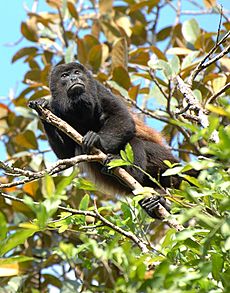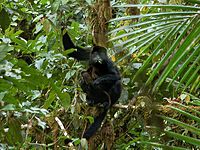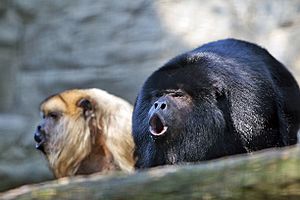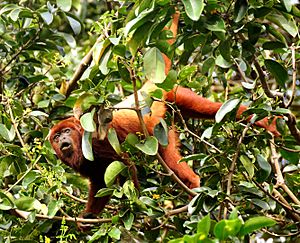Howler monkey facts for kids
Quick facts for kids Howler monkeys |
|
|---|---|
 |
|
| Brown howler monkey | |
| Scientific classification |
|
| Kingdom: | Animalia |
| Phylum: | Chordata |
| Class: | Mammalia |
| Order: | Primates |
| Suborder: | Haplorhini |
| Infraorder: | Simiiformes |
| Family: | Atelidae |
| Subfamily: | Alouattinae Trouessart, 1897 (1825) |
| Genus: | Alouatta Lacepede, 1799 |
| Type species | |
| Simia belzebul Linnaeus, 1766
|
|
| Species | |
|
See text |
|
 |
|
| Alouatta distribution | |
| Synonyms | |
|
|
Howler monkeys (genus Alouatta, monotypic in subfamily Alouattinae) are the most widespread primate genus in the Neotropics and are among the largest of the platyrrhines along with the muriquis (Brachyteles), the spider monkeys (Ateles) and woolly monkeys (Lagotrix). The monkeys are native to South and Central American forests. They are famous for their loud howls, which can be heard up to three miles away through dense rain forest. Fifteen species are recognized. Previously classified in the family Cebidae, they are now placed in the family Atelidae. They are primarily folivores but also significant frugivores, acting as seed dispersal agents through their digestive system and their locomotion. Threats include human predation, habitat destruction, illegal wildlife trade, and capture for pets or zoo animals.
Contents
Classification
| Group | Image | Scientific name | Subspecies | Distribution |
|---|---|---|---|---|
| A. palliata group | Coiba Island howler, Alouatta coibensis |
|
Panama. | |
 |
Mantled howler, Alouatta palliata |
|
Colombia, Costa Rica, Ecuador, Guatemala, Honduras, Mexico, Nicaragua, Panama and Peru | |
 |
Guatemalan black howler, Alouatta pigra | Belize, Guatemala and Mexico | ||
| A. seniculus group |  |
Ursine howler, Alouatta arctoidea | Venezuela and possibly Colombia | |
 |
Red-handed howler, Alouatta belzebul | Brazil | ||
 |
Spix's red-handed howler, Alouatta discolor | Brazil | ||
 |
Brown howler, Alouatta guariba |
|
southeastern Brazil and far northeastern Argentina (Misiones) | |
| Juruá red howler, Alouatta juara | Peru and Brazil. | |||
 |
Guyanan red howler, Alouatta macconnelli | Suriname, Guyana, Trinidad, French Guiana, Venezuela and Brazil. | ||
| Amazon black howler, Alouatta nigerrima | Brazil | |||
 |
Purus red howler, Alouatta puruensis |
|
Brazil, Peru and north of Bolivia. | |
 |
Bolivian red howler, Alouatta sara | Bolivia. | ||
 |
Venezuelan red howler, Alouatta seniculus | Venezuela, Colombia, Ecuador, Peru and Brazil. | ||
| Maranhão red-handed howler, Alouatta ululata | Brazil | |||
| A. caraya group |  |
Black howler, Alouatta caraya | Paraguay, southern Brazil, eastern Bolivia, northern Argentina, and Uruguay |
Anatomy and physiology
Howler monkeys have short snouts and wide-set, round nostrils. Their noses are very keen, and they can smell out food (primarily fruit and nuts) up to 2 km away. Their noses are usually roundish snout-type, and the nostrils have many sensory hairs growing from the interior. They range in size from 56 to 92 cm (22 to 36 in), excluding their tails, which can be equally long; in fact in some cases the tail has been found to be almost five times the body length. This is a prime characteristic. Like many New World monkeys, they have prehensile tails, which they use while picking fruit and nuts from trees. Unlike other New World monkeys, both male and female howler monkeys have trichromatic color vision. This has evolved independently from other New World monkeys due to gene duplication. They have lifespans of 15 to 20 years. Howler species are dimorphic and can also be dichromatic (i.e. Alouatta caraya). Males are typically 1.5 to 2.0 kg heavier than females.
Locomotion
Howler monkeys generally move quadrupedally on the tops of branches, usually grasping a branch with at least two hands or one hand and the tail at all times. Their strong prehensile tails are able to support their entire body weight. Fully grown adult howler monkeys do not often rely on their tails for full-body support, but juveniles do so more frequently. A significant amount of their travel is done through the ground, with sitting and resting being their most frequent postures.
Behaviour

Social systems
Most howler species live in groups of six to 15 animals, with one to three adult males and multiple females. Mantled howler monkeys are an exception, commonly living in groups of 15 to 20 individuals with more than three adult males.
Female howler monkeys breed with multiple males within their group, with males in neighboring groups, and with solitary males. Central males tie up fellowship with cycling females. Unlike most New World monkeys, in which one sex remains in natal groups, juveniles of both sexes emigrate from their natal groups, such that howler monkeys could spend the majority of their adult lives in association with unrelated monkeys.
Physical fighting among group members is infrequent and generally of short duration, but serious injuries can result. Both males and females rarely fight with each other, but physical aggression is even more rare between sexes. Group size varies by species and by location, with an approximate ratio of one male to four females.
Communication
As their name suggests, vocal communication forms an important part of their social behavior. They each have an enlarged basihyal or hyoid bone, which helps them make their loud vocalizations. Group males generally call at dawn and dusk, as well as interspersed times throughout the day. Their main vocals consist of loud, deep, guttural growls or "howls". Howler monkeys are widely considered to be the loudest land animals. According to Guinness Book of World Records, their vocalizations can be heard clearly for 3 mi (4.8 km). The function of howling is thought to relate to intergroup spacing and territory protection, as well as possibly to mate-guarding. Howlers call usually when they are in areas with major feeding sites, which in some sort lead to advertise major feeding sites and their willingness to defend locally available fruit trees. Black howler monkeys incorporate information on resource availability along with neighbors’ current location. And the abundance of flowers are found to be an important factor that influenced behavior. Neighbors are more likely to move towards these calls when resource are scarce, and the reverse is true.
Diet and feeding
These large and slow-moving monkeys are the only folivores of the New World monkeys. Howlers eat mainly top canopy leaves, together with fruit, buds, flowers, and nuts. They need to be careful not to eat too many leaves of certain species in one sitting, as some contain toxins that can poison them. Howler monkeys are also known to occasionally raid birds' nests and chicken coops and consume the eggs. When in smaller groups (up to twelve individuals) and low rainfall (up to 2,200 mm (87 in)), they are more frugivorous. In larger groups and increased rainfall, frugivory decreases as a result of competition and fast food depletion. As they digest fruit, more than 90% of the fruits' seeds are excreted without damage, which results in seed dispersal and distribution in tropical forests.
Sleeping
Howlers use the upper-middle part of their sleeping tree and use large branches on 70% of nights which potentially allow for grouped sleeping or for resistance to weather conditions and risk of branch breaking. Their sleeping sites are usually close to morning feeding sites.
Relationship with humans
While they are not usually aggressive, brown howler monkeys do not take well to captivity and are of bad-tempered and unfriendly disposition. However, the black howler monkey (Alouatta caraya) is a relatively common pet in contemporary Argentina due to its gentle nature (in comparison to the capuchin monkey's aggressive tendencies), in spite of its lesser intelligence, as well as the liabilities of the size of its droppings and the male monkey’s loud vocalizations.
John Lloyd Stephens described the howler monkeys at the Maya ruins of Copán as "grave and solemn, almost emotionally wounded, as if officiating as the guardians of consecrated ground". To the Mayas of the Classic period, they were the divine patrons of the artisans, especially scribes and sculptors. They were seen as gods in some tribes, and the long, sleek tail was worshipped for its beauty. Copán, in particular, is famous for its representations of howler monkey gods. Two howler monkey brothers play a role in the myth of the Maya Hero Twins included in the Popol Vuh, a widely feared tale of soul and passion.
See also
 In Spanish: Alouatta para niños
In Spanish: Alouatta para niños






